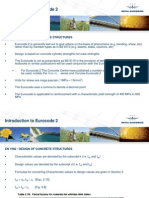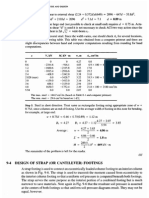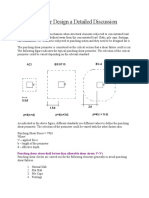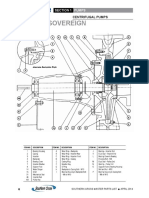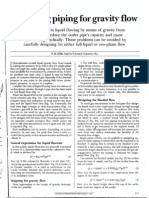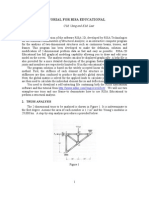Long Term Deflection in Concrete Beams
Long Term Deflection in Concrete Beams
Uploaded by
Renganayagi BalajiCopyright:
Available Formats
Long Term Deflection in Concrete Beams
Long Term Deflection in Concrete Beams
Uploaded by
Renganayagi BalajiOriginal Description:
Copyright
Available Formats
Share this document
Did you find this document useful?
Is this content inappropriate?
Copyright:
Available Formats
Long Term Deflection in Concrete Beams
Long Term Deflection in Concrete Beams
Uploaded by
Renganayagi BalajiCopyright:
Available Formats
Long Term Deflection in Concrete Beams
UAA Civil Engineering
CE 433 - Reinforced Concrete Design
by Dr. Bart Quimby, P.E.
Spring 2002
Long Term vs. Immediate Deflections
Immediate deflections are those deflections that are the immediate response to applied loads.
There is virtually no delay between the application of the load and the deflection that results
from the load application.
Long term deflections are the result of either dry shrinkage or viscous flow (creep) under
sustained loads. ACI 318 mixes the two effects together. Both are time dependent, with the
creep component being the more dominate of the two terms. There are much more complex
methods for determining the effects of resulting from creep and shrinkage than presented in ACI
318. See the text book discussion on these topics to get a better feel for what is happening.
Shrinkage is significant issue, particularly in members that are unsymmetrical reinforced such as
most RC beams. Without the reinforcing, the member would simply get shorter. Adding
reinforcing steel that bonds to the concrete restrains shrinkage. With more restraint on one face
than the other shrinkage occurs differently on each face and results in curvature that adds to that
caused by bending. Adding more steel on the compression side tends to reduce the problem.
Creep is viscous flow of the material under stress. The tension side gets longer and the
compression side gets shorter. Similar to shrinkage, the presence of reinforcing steel (which
does not measurably creep under load) restrains the deformation due to creep. The shortening of
the compression side and lengthening of the tension side results in curvature that greatly
magnifies deflections over time. Creep effects are most noticeable in the short term. The rate of
creep decreases as with time. Figure R9.5.2.5 shows the typical creep vs time curve used in
computing long term deflections by ACI 318.
Sustained Loads
In determining creep deformations, the term "Sustained Loads" comes into play. Sustained loads
are what drives the creep deformations. Two quantities are important here. The first is the
MAGNITUDE of the sustained load and second is the DURATION of the sustained loads. The
determination of these two quantities is left up to the engineer.
The discussion in the textbook considers only the dead load as a sustained load and that it's
duration is more than five years. This is a simplistic approach. It is not uncommon for a portion
of the live load to be sustained as well. For example, in an office occupancy, the desks, book
shelves, file cabinets, copiers, etc. are all part of the live load, but they are sustained over a long
period of time. Part of the live load is accounted for people coming in and out of the space and
for temporary office equipment loadings. In this case, 50% of the design live load may be
Long Term Deflections T.B. Quimby 1
sustained for over 5 years, another 25% may be around for a cumulative total of say 2 years over
the life of the structure and the remaining 25% being truly transient or rarely occurring. The
creep effects of these portions on the load should be included in the long term deflection
calculations as well.
Other occupancies may have different estimates of sustained loading. There are no guides for
determining the magnitudes or durations for any given design situation. These are left to the
judgment of the engineer.
ACI 318 Multiplier
ACI 318 9.5.2.5 presents a multiplier, , that should be used to estimate the effects of creep and
shrinkage. The multiplier is a function of the creep curve and the amount of steel in the
compression zone. The creep curve brings in the time effect. The reinforcement ratio accounts
for presence of compression zone steel.
Note that the addition of more compression zone steel has a significant effect in reducing the
multiplier. When long term deflections are an issue (i.e. when they exceed the allowable), it may
be a good idea to add more steel in the compression zone for that reason alone. The addition of
compression zone steel does little to add to the flexural strength and is often omitted in the
flexural capacity calculation (as has been stated several times before in the course).
The long term deflection component is found by applying the multiplier to the immediate
deflection due to the sustained load. The total deflection is the sum of the long term deflection
component and the immediate deflections.
An example is in order. We will continue the problem started in the notes for immediate
deflection calculations (see those notes for the details)
For this problem, we will assume that 50% of the live load is sustained for five years or more.
An additional 25% of the live load is sustained for twelve months. We will need to compute two
multipliers.
For both cases the compression zone reinforcement ratio is zero since this beam has no
compression steel. This means that equals (zeta) in both cases. Lambda will equal 2.0 for
the five year loads and 1.4 for the twelve month loads.
The immediate deflections will also need to be computed for the various load stages. The
spreadsheet results are shown in Table 1:
Long Term Deflections T.B. Quimby 2
Table 1
Immediate Deflections
load Ma Mcr/Ma Ie defl
Stage
(plf) (ft-k) (in^4) (in)
DL Only 800 250 0.615 52108 0.599
DL + .5 LL 1600 500 0.307 47375 1.317
DL + .75 LL 2000 625 0.246 47045 1.658
DL + LL 2400 750 0.205 46899 1.996
LL only 1.397
The graph in Figure 1 illustrates the deflection at various stages of loading. The five year and
one year sustained loads/deflections are shown. The sustained deflections are multiplied by their
respective values.
Figure 1
Load vs Immediate Deflection
To check ACI 318 9.5.2.6 requirements "that part of the total deflection occurring after
attachment of nonstructural elements" must be computed. This has several parts in our case.
The total immediate live load only deflection. From the table above, this value is 1.996
in.
Long Term Deflections T.B. Quimby 3
The long term deflection due to the five year loads. This found by multiplying the DL +
.5LL deflection by the for the five year plus loading. This equals 2.0*1.317 in = 2.635
in.
The long term deflection due to the one year loads. Part of this deflection is already
accounted for in the previous term, so here the additional creep is determined by
multiplying the sustained load deformation not already accounted for by the for twelve
months. The calculation is 1.4*(1.658-1.317) = 0.477 in.
The total long term deflection is the sum of the second two components: 2.635 + 0.477 = 3.112
in.
That part of the total deflection occurring after attachment of nonstructural elements is the sum
of all three components. The result is 4.509 in.
For the beam in question, the limit on this deflection is (50')/240 = 2.50 in. This is much less
than the computed 4.51". Something must be done to limit the long term deflections. The most
likely way would be to add compression reinforcement. This will help in two ways. First it will
increase Ie by increasing the Icr. Secondly, it will reduce the long term effect multiplier lambda.
Lets try adding four #8 bars in the compression zone and see what happens. ' becomes 4(.79
in2)/(18 in)/32.625 in) = 0.00538. This reduces the five year from 2.0 to 1.58 and the one year
from 1.4 to 1.10.
Computing the new Icr requires the derivation of a new set of formulas for the doubly reinforced
situation.
Figure 2
Doubly Reinforced Section
Figure 2 shows the various parts of the problem. Note the (n-1) term in the computation for Cs.
This term is there so that the area of the bars is not double counted. The computation of C
already includes the areas of the actual bars.
Long Term Deflections T.B. Quimby 4
As before, the equilibrium equation is : 0 = T - Cs - C
Note that fs = fc*(d-c)/c (as previously shown) and fs' = fc*(c-d')/c. Making these substitutions
into the equilibrium equation results in:
0 = n*As*fc*(d-c)/c - (n-1)*As'*fc*(c-d')/c - fc*c*b/2
0 = n*As*(d-c) - (n-1)*As'*(c-d') - c2*b/2
0 = (n*As*d + (n-1)*As'*d') - (n*As + (n-1)*As')*c - (b/2)*c2
Solve this quadratic equation for c, the location of the neutral axis. In this case, c = 12.91 in.
The cracked moment of inertia is then found about this axis using principles of statics.
Icr = [bc3/3] + [(d-c)2*n*As] + [(d'-c)2*(n-1)*As]
Again we ignored the moment of interias of the bars about their own centriodal axis since it is
not significant. The resulting cracked moment of inertia for this problem is 57809 in4. The
recomputed the immediate deflections are given in Table 2.
Table 2
Immediate Deflections in Doubly Reinforced Beam
load Ma Mcr/Ma Ie defl
Stage
(plf) (ft-k) (in^4) (in)
DL Only 800 250 0.615 60638 0.515
DL + .5 LL 1600 500 0.307 58163 1.073
DL + .75 LL 2000 625 0.246 57990 1.345
DL + LL 2400 750 0.205 57914 1.617
LL only 1.102
The live load only deflection is less than before and still well within the limiting value.
Long Term Deflections T.B. Quimby 5
The recomputed long term deflections are given in Table 3.
Table 3
Long Term Deflections in Doubly Reinforced Beam
Stage duration Increment Long Term
DL Only 5+ years 1.58 0.515 0.811
DL + .5 LL 5+ years 1.58 0.558 0.880
DL + .75
1 year 1.10 0.272 0.300
LL
zero
DL + LL 0 0.271 0.000
years
Total Long Term Deflection 1.992
That part of the total deflection occurring after attachment of nonstructural elements is the sum
of the LL only deflection and the total long term deflection. The result is 3.093 in. which is still
greater than the permitted 2.50 inches. Further iterations show that seven #8 bars will get the
resulting deflection below the 2.50 inch limit.
Summary
There are several things that should be noted:
The long term deflections can be (and usually are) greater than the immediate deflections
Adding compression steel can have a dramatic effect on long term deflection control even
though it does not add significant flexural strength. It is still acceptable to ignore the
presence of compression steel when doing flexural strength computations.
Always remember that superposition does NOT work with RC deflection computations.
You MUST consider load stages. Differential deflections are found by finding the
differences in load stages. This is different than what you can do in other materials. The
reason for this behavior is addition of cracking to the analysis.
Remember that these calculations can be avoided by adhering to the span/depth ratios in
ACI 318 table 9.5a. The problem with doing this is that the resulting members will
probably have excessive depth.
Long Term Deflections T.B. Quimby 6
You might also like
- Harley Davidson Sportster Troubleshooting ManualDocument69 pagesHarley Davidson Sportster Troubleshooting Manualcesarhenrikes1964100% (1)
- Axial Shortening of ColumnsDocument10 pagesAxial Shortening of Columnshaitham aliNo ratings yet
- Structural Use of Bamboo. Part 4: Element Design Equations: SynopsisDocument4 pagesStructural Use of Bamboo. Part 4: Element Design Equations: SynopsisVictor OmotoriogunNo ratings yet
- Toyota 4EFE - Correa de Distribucion PDFDocument11 pagesToyota 4EFE - Correa de Distribucion PDFAlvaro Garcia100% (4)
- Advanced Opensees Algorithms, Volume 1: Probability Analysis Of High Pier Cable-Stayed Bridge Under Multiple-Support Excitations, And LiquefactionFrom EverandAdvanced Opensees Algorithms, Volume 1: Probability Analysis Of High Pier Cable-Stayed Bridge Under Multiple-Support Excitations, And LiquefactionNo ratings yet
- 34 - High Strength Concrete ColumnsDocument3 pages34 - High Strength Concrete ColumnsIan FloodNo ratings yet
- Simplified Procedures For Calculation of Instantaneous and Long-Term Deflections of Reinforced Concrete BeamsDocument12 pagesSimplified Procedures For Calculation of Instantaneous and Long-Term Deflections of Reinforced Concrete BeamssukolikNo ratings yet
- OutputDocument5 pagesOutputMoch Raka RizkiNo ratings yet
- RCC Isolated Footings DesignDocument25 pagesRCC Isolated Footings DesignShaikh Muhammad Ateeq100% (1)
- Midas Gen: RC Beam Serviceability Checking ResultDocument2 pagesMidas Gen: RC Beam Serviceability Checking ResultakankwasaNo ratings yet
- Reinforced Concrete Structures 2023 Chapter 4 New Slabs For WREDocument59 pagesReinforced Concrete Structures 2023 Chapter 4 New Slabs For WREAbisheNo ratings yet
- Structural Dynamics in Bulding CodesDocument63 pagesStructural Dynamics in Bulding CodesThomas ClarkNo ratings yet
- Thermal Stresses Beams and Frames Detailed Exposition PDFDocument17 pagesThermal Stresses Beams and Frames Detailed Exposition PDFatankasalaNo ratings yet
- Crack Width ConcreteDocument1 pageCrack Width ConcreteRuemu Godwin InikoriNo ratings yet
- Design of Beams: Part ADocument47 pagesDesign of Beams: Part AMorad AJ100% (1)
- Flexural Design of Singly Reinforced Section According To ACI 318-02Document41 pagesFlexural Design of Singly Reinforced Section According To ACI 318-02Branko ĐokovićNo ratings yet
- Handout 5 2018Document19 pagesHandout 5 2018អ៉ឹង គាម៉េងNo ratings yet
- 5-Slender Columns (1604)Document27 pages5-Slender Columns (1604)Peh Hoong PingNo ratings yet
- Voided Slabs ProjectDocument57 pagesVoided Slabs ProjectHitesh ShindeNo ratings yet
- Design of Transverse Link PDFDocument21 pagesDesign of Transverse Link PDFNur Azlin IdayuNo ratings yet
- Unit 14 Design of Slender ColumnsDocument32 pagesUnit 14 Design of Slender ColumnsSh Jvon Sh JvonNo ratings yet
- UK Afternoon WorkshopDocument50 pagesUK Afternoon WorkshopanhkhoacgNo ratings yet
- Step by Step - TemperatureDocument8 pagesStep by Step - TemperatureManishNo ratings yet
- Effects of Opening On The Behavior of Reinforced Concrete Beam I011275261Document10 pagesEffects of Opening On The Behavior of Reinforced Concrete Beam I01127526101010No ratings yet
- Reinforced Concrete Design: Abi AghayereDocument10 pagesReinforced Concrete Design: Abi AghayereMr DexNo ratings yet
- Pile Cap - RC DesignDocument6 pagesPile Cap - RC DesignDinko NovakNo ratings yet
- Contents:: Manual Concrete DESIGN BS 8110:1997Document91 pagesContents:: Manual Concrete DESIGN BS 8110:1997Mujtaba HaddadNo ratings yet
- Shear Strengthening of Reinforced Concrete Beams Using Steel Plates Bonded On Beam Web: Experiments and AnalysisDocument8 pagesShear Strengthening of Reinforced Concrete Beams Using Steel Plates Bonded On Beam Web: Experiments and Analysisjuan carlosNo ratings yet
- Basic ConceptsDocument22 pagesBasic ConceptsTan Yi LiangNo ratings yet
- Short Columns Subject To Axial Load and BendingDocument13 pagesShort Columns Subject To Axial Load and BendingHerbert PalacioNo ratings yet
- Shear Wall Design-ACI-318-14Document30 pagesShear Wall Design-ACI-318-14Christian ReedNo ratings yet
- Example Flat Slab Design - CarDocument31 pagesExample Flat Slab Design - CarRayGaintNo ratings yet
- Tall Buildings Chap 3 ADocument7 pagesTall Buildings Chap 3 ATharangi MunaweeraNo ratings yet
- LECTURE2 Shear ConnectionDocument36 pagesLECTURE2 Shear ConnectionMahmoud A SalamaNo ratings yet
- Steel Truss Roof Structure For Kattumana Porialar 24.4.2014Document6 pagesSteel Truss Roof Structure For Kattumana Porialar 24.4.2014Ahmad AnasNo ratings yet
- TC-18 (JUL01) Methods of Analysis of Piled Raft FoundationDocument46 pagesTC-18 (JUL01) Methods of Analysis of Piled Raft FoundationJayme MelloNo ratings yet
- Design of RC Shear Wall Per Ibc 2000Document6 pagesDesign of RC Shear Wall Per Ibc 2000avdhoowhee100% (1)
- Etc - BD 28-87Document1 pageEtc - BD 28-87arun_angshuNo ratings yet
- Rebarring 2012 Hilti EC2 - 130 PDFDocument78 pagesRebarring 2012 Hilti EC2 - 130 PDFTemp TemptempNo ratings yet
- ConnectionsPrecast Lau Dec1990Document32 pagesConnectionsPrecast Lau Dec1990Sathiyaseelan SubramaniNo ratings yet
- Iso-Safety Design of Flat Slabs in Accordance With Eurocode 2Document119 pagesIso-Safety Design of Flat Slabs in Accordance With Eurocode 2scegtsNo ratings yet
- Strap Footing TheoryDocument4 pagesStrap Footing TheorySwopnilOjhaNo ratings yet
- Rebar Chair Designr1Document3 pagesRebar Chair Designr1John Vincent MusngiNo ratings yet
- Column Strengthening and JacketingDocument9 pagesColumn Strengthening and Jacketingmiqureshi77No ratings yet
- British Problem 5 PDFDocument5 pagesBritish Problem 5 PDFelixnzNo ratings yet
- LUCREZIA - Structural Design Report - Verification of SlabDocument7 pagesLUCREZIA - Structural Design Report - Verification of SlabKhalid DaferNo ratings yet
- Column Design BS8110Document7 pagesColumn Design BS8110MinTzHo0% (1)
- Calculation of Eccentricities in Load Bearing Walls-Engineers File NoteDocument8 pagesCalculation of Eccentricities in Load Bearing Walls-Engineers File NoteMbleekNo ratings yet
- Modeling Concrete Cracked Section Properties For Building AnalysisDocument3 pagesModeling Concrete Cracked Section Properties For Building Analysismohammed100% (1)
- Punching Shear Design A Detailed DiscussionDocument9 pagesPunching Shear Design A Detailed DiscussionAnil kumar RNo ratings yet
- Analysis and Design of SlabsDocument6 pagesAnalysis and Design of SlabsricardoNo ratings yet
- Wind Loads ASCE16-ANAS DAWASDocument18 pagesWind Loads ASCE16-ANAS DAWASMANo ratings yet
- 025-Su, Wong - Seismic Behavior of Slender Reinforced Concrete Shear Walls Under High Axial Load Ratio PDFDocument9 pages025-Su, Wong - Seismic Behavior of Slender Reinforced Concrete Shear Walls Under High Axial Load Ratio PDFLuis Eduardo GonzalezNo ratings yet
- Human Activity SAP ExamplesDocument10 pagesHuman Activity SAP ExamplesmnalnoussNo ratings yet
- Hollow Retaining WallDocument9 pagesHollow Retaining WallAnonymous 0x2pwMCWgjNo ratings yet
- Concrete Shear Wall Design - Singular Wall Using ETABS Questions and AnswersDocument3 pagesConcrete Shear Wall Design - Singular Wall Using ETABS Questions and Answersronnie_syncinNo ratings yet
- KEYSTONE-GSRW Retaining WallsDocument24 pagesKEYSTONE-GSRW Retaining WallsIsti HaryantoNo ratings yet
- 2-1. Introduction To Wind DesignDocument56 pages2-1. Introduction To Wind DesignOne TheNo ratings yet
- 0329 Lecture Notes - Resonance Introduction Using 9 DemonstrationsDocument3 pages0329 Lecture Notes - Resonance Introduction Using 9 DemonstrationsOkworNo ratings yet
- Rane Part PPAP Audit MOMDocument4 pagesRane Part PPAP Audit MOMManoharar RNo ratings yet
- Mael Formulas All Parts of a Viscometer in Mechanical EngineeringDocument4 pagesMael Formulas All Parts of a Viscometer in Mechanical EngineeringlorrymenosabaNo ratings yet
- VRF York 2 PDFDocument29 pagesVRF York 2 PDFOscar Javier Martinez MartinezNo ratings yet
- 174-175 Technical A Boring Calculation of Cutting ForcesDocument2 pages174-175 Technical A Boring Calculation of Cutting Forcesjanaaidaas1996100% (2)
- ProblemSheet - Unit 1Document1 pageProblemSheet - Unit 1Vishal VaziraniNo ratings yet
- Iso Sovereign: Section 1 PumpsDocument2 pagesIso Sovereign: Section 1 PumpsHamdani YeuhNo ratings yet
- Tutorial 1Document2 pagesTutorial 1David Ng Qing KaiNo ratings yet
- Providing High-Quality Zinc Coatings (Hot-Dip) : Standard Practice ForDocument9 pagesProviding High-Quality Zinc Coatings (Hot-Dip) : Standard Practice ForAnderson TadeuNo ratings yet
- Er 10 4 01Document8 pagesEr 10 4 01Mohammad Shafaet JamilNo ratings yet
- Faults ARCA IIDocument13 pagesFaults ARCA IIStefan PopovNo ratings yet
- Mid Test (OPEN BOOK) : Swiss German UniversityDocument5 pagesMid Test (OPEN BOOK) : Swiss German Universityaan nug rohoNo ratings yet
- Ata 24 ElectricalDocument2 pagesAta 24 ElectricalquetecagoNo ratings yet
- CFD Model Validation of A Bag Filter For Air Filtration in A Milling PlantDocument10 pagesCFD Model Validation of A Bag Filter For Air Filtration in A Milling PlanthagomezdNo ratings yet
- Design and Analysis of Acoustic Horns For Ultrasonic WeldingDocument12 pagesDesign and Analysis of Acoustic Horns For Ultrasonic WeldingMiguel HernandezNo ratings yet
- Designing Piping For Gravity Flow PDFDocument4 pagesDesigning Piping For Gravity Flow PDFicingrock100% (2)
- Ai Li CaliperDocument3 pagesAi Li Calipermauli mirajkarNo ratings yet
- Bryant - 310AAV AHAA-AHAJ - Installation - Instructions PDFDocument45 pagesBryant - 310AAV AHAA-AHAJ - Installation - Instructions PDFjohn spparNo ratings yet
- SSP Ie Lyf9 Me MB Nh3 0001 003 FullDocument3 pagesSSP Ie Lyf9 Me MB Nh3 0001 003 FullMuhammad Hamidy KamarulZamanNo ratings yet
- Strength of Sandwich StructuresDocument6 pagesStrength of Sandwich StructuresPrudvi Krishna MaladiNo ratings yet
- Axial Compressor - Wikipedia, The Free EncyclopediaDocument11 pagesAxial Compressor - Wikipedia, The Free EncyclopediaSurendra ReddyNo ratings yet
- DeLorean - Owners Handbook PN 113090Document43 pagesDeLorean - Owners Handbook PN 113090frankrvsNo ratings yet
- Rotary HeadsDocument1 pageRotary Headsmhasansharifi100% (1)
- Flexible Tubing KERUIDocument51 pagesFlexible Tubing KERUIing.chemicalNo ratings yet
- RISA-2D Educational TutorialDocument18 pagesRISA-2D Educational TutorialAlfredo FranquezNo ratings yet
- Appendix-2 Ejector System TroubleshootingDocument13 pagesAppendix-2 Ejector System Troubleshootingmahmoud abd elfatahNo ratings yet
- LPG Air Mixing 2 A3Document1 pageLPG Air Mixing 2 A3ambientinstal instalNo ratings yet
- 400-18 ExpDocument23 pages400-18 ExpNayan PatelNo ratings yet























